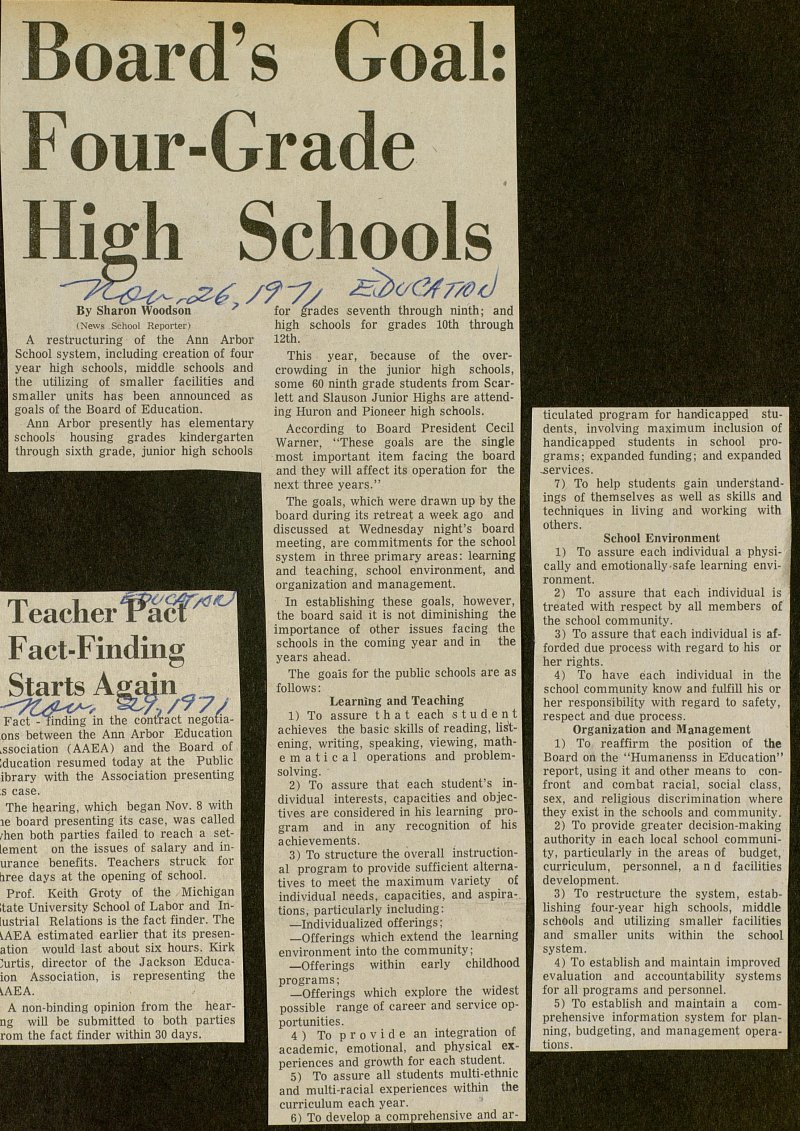Board's Goal: Four-Grade High Schools

A restructuring of the Ann Arbor School system, including creation of four year high schools, middle schools and the utilizing of smaller facilities and smaller units has been announced as goals of the Board of Education. Ann Arbor presently has elementary schools housing grades kindergarten through sixth grade, junior high schools for grades seventh through ninth; and I high schools for grades l0th through I 12th. This year, Iecause of the I crowding in the junior high schools, I some 60 ninth grade students from Scarlett and Slauson Junior Highs are I ing Huron and Pioneer high schools. According to Board President Cecil Warner, "These goals are the single most important item facing the board and they will affect its operation for the next three years." The goals, which were drawn up by the board during its retreat a week ago and discussed at Wednesday night's board meeting, are commitments for the school system in three primary areas: learning and teaching, school environment, and organization and management. In establishing these goals, however, the board said it is not diminishing the importance of other issues facing the schools in the coming year and in the years ahead. The goals for the public schools are as follows : Learning and Teaching 1) To assure t h a t each student achieves the basic skills of reading, listening, writing, speaking, viewing, mathe m a t i c a 1 operations and problemsolving. ' 2) To assure that each student's individual interests, capacities and objectives are considered in his learning program and in any recognition of his achievements. 3) To structure the overall instructional program to provide sufficient alternatives to meet the maximum variety of individual needs, capacities, and aspirations, particularly including: - Individualized offerings ; - Offerings which extend the learning environment into the community; - Offerings within early childhood programs; -Offerings which explore the widest possible range of career and service opportunities. 4) To provide an integration of academie, emotional, and physical experiences and growth for each student. 5) To assure all students multi-ethnic and multi-racial experiences within the curriculum each year. 6) To develop a comprehensive and ticulated program for handicapped I dents, involving maximum inclusión of I handicapped students in school I grams; expanded funding; and expanded I services. 7) To help students gain I ings of themselves as well as skills and I techniques in living and working with others. School Environment 1) To assure each individual a physically and emotionally-safe learning environment. 2) To assure that each individual is treated with respect by all members of I the school community. 3) To assure that each individual is I forded due process with regard to his or I her rights. 4) To have each individual in the I school community know and fulfill his or I her responsibility with regard to safety, I respect and due process. Organization and Management 1) To reaffirm the position of the I Board on the "Humanenss in Education" report, using it and other means to confront and combat racial, social class, sex, and religious discrimination where I they exist in the schools and community. I 2) To provide greater decision-making I authority in each local school I ty, particularly in the areas of budget, I curriculum, personnel, and facilities I development. I 3) To restructure the system, I lishing four-year high schools, middle I schools and utilizing smaller facilities I and smaller units within the school I system. 4) To establish and maintain improved I evaluation and accountability systems I for all programs and personnel. 5) To establish and maintain a I prehensive information system for I ning, budgeting, and management I tions. I